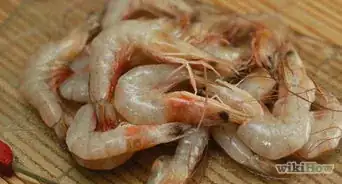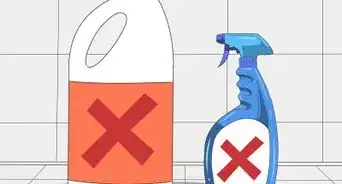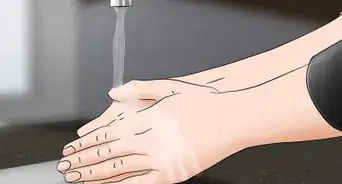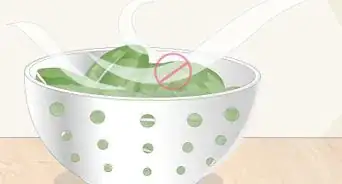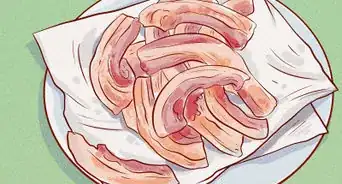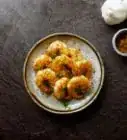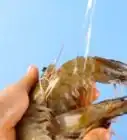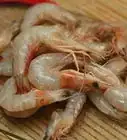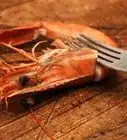This article was co-authored by Anne Lloyd. Chef Anne Lloyd is a Professional Chef and the Owner of Nolavore in New Orleans, Louisiana. Chef Anne has had a career in the restaurant and food service industries for over 30 years and has traveled and cooked on both coasts of the United States as well as in Europe and Southeast Asia. She specializes in utilizing local and regional foods to create dishes featuring international flavors. She also provides full-service catering, prepared foods, gourmet packaged goods, pantry items, and kids' cooking camps and classes for all ages. She received a BA in Anthropology from the University of California, Santa Cruz, and her Associate of Arts, Culinary Arts degree from the California Culinary Academy. Anne is an alumna of the Goldman Sachs 10,000 Small Businesses Summit.
There are 8 references cited in this article, which can be found at the bottom of the page.
This article has been viewed 103,374 times.
Prawns are a delicious addition to any seafood dish. To get the freshest prawns, make sure you pay attention to the packaging, the color, and the odor. When you clean your prawns, rinse them in cold water before you begin de-shelling and deveining. You'll need to remove the head, the tail, and the legs before cooking for most recipes.
Things You Should Know
- Rinse the prawns thoroughly in cold water.
- Remove the prawn's head and tail. Then, peel off the shell and legs.
- Use a sharp knife to devein the prawn's body. Rinse again with cold water.
Steps
Rinsing and Storing Prawns
-
1Defrost the prawns. If your prawns were frozen, you'll need to defrost them. Empty the prawns into a large bowl, preferably glass. Pour in some cold water and stir it around. Then drain the prawns and repeat this step several times. The entire process should take about fifteen minutes to fully defrost your prawns.[1]
- Using the microwave to defrost prawns can make them soggy or overcooked.
-
2Rinse the prawns in cold water. Put the prawns in a colander and rinse them in the sink with cold water. Use your hands to rinse each prawn individually. As you are rinsing, keep an eye out for any spoiled prawns that are discolored or slimy. Prawns should appear white or gray before cooking.[2]
- Never use water that is warmer than room temperature, as this could lead to soggy or rubbery prawns.
Advertisement -
3Cook the prawns soon after cleaning. Prawns should ideally be cooked immediately after cleaning. However, if you must store them for later, be sure to keep them in the refrigerator for no more than 24 hours. After this length of time, they may start to go bad.
- For the freshest, best tasting prawns, consider cleaning and cooking them as soon as you get home from the store.
-
4Store the cleaned prawns in the refrigerator. Prawns need to be stored in a cool place like the refrigerator. They should be stored at a temperature between 32 °F (0 °C) and 38 °F (3 °C). Keep them together on a tray covered with plastic wrap or in a plastic container while they are in the fridge.
- You can also freeze prawns for up to three months in your freezer at −18 °C (0 °F), but this may lead to less fresh tasting prawns.
- Prawns should never be left out at room temperature for more than a few minutes.
Preparing the Body
-
1Remove the prawn head. Hold the prawn by the body with one hand and use your other hand to firmly grasp the prawn's head. Place the fingers from both hands at the intersection of the head and the body, where you want the break to occur. Pull back with both hands and twist until the head detaches.[3]
- Discard the unused prawn heads in the trash immediately.
-
2Pull off the tail. Hold the prawn by the body and grab the prawn tail with your other hand. Using a firm grip, pull the prawn tail off where it connects with the meaty part of the body. Throw away the tail once you remove it.[4]
- Removing the tail before the rest of the shell will make the deshelling process much easier.
-
3Peel off the shell and legs. Once you have removed the shell, you should be able to peel off the remainder of the prawn's outer layer quite easily. Use your fingers to pull the legs off from its underside. Then peel back any remaining pieces of the shell.[5]
- This should leave you with just the meaty part of prawn left.
-
4Devein the prawn. Use a sharp knife to cut a small line that runs down the length of the prawn's back. This should be done on the top of the prawn, the opposite side from where the legs were. Inside, you will see a small black line. Use the tip of the knife to pull out the vein and discard it.[6]
- This black vein is the prawn's intestines. Removing it will help your prawns taste much better.
- After deveining the prawns, you should rinse them once more with cold water. This will help ensure all remnants of the intestines are completely removed.
Choosing Good Prawns
-
1Choose uncooked prawns with the shell still on. It may seem more convenient to choose prawns that have already been cooked or deshelled, but this will yield a great sacrifice in taste. Prawns taste best after the first time they are cooked, so it is important to purchase raw prawns.
- Removing the shell gets rid of all the oils on the prawn, so choose prawns that have not been deshelled to help maintain the full flavor.
-
2Purchase prawns on ice. Prawns should be purchased fresh and stored on a bed of ice in the meat section of your market or grocery store. This allows you to inspect them for discoloration and smell, and you will be able to choose the best ones.[7]
- Buying prepackaged prawns means you will get prawns that are much older and will not taste nearly as good.
-
3Look at the color. Prawns should be white or grayish in color with only white meat. Inspect each prawn for spots or areas of discoloration that indicate spoilage. Only choose prawns that are light in color and have no darker spots on them.
- There are also brown varieties of prawns that should appear brown in color. These, too, should have no spots or discolored areas.
-
4Notice the smell. While all seafood smells slightly fishy, prawns should not be too odorous. If there is a strong fishy smell to them, that means they are probably going bad. Choose prawns that smell fresh and clean, with only a hint of that seafood smell.[8]
- This is another reason you should only purchase fresh prawns instead of prepackaged ones. If they are wrapped up in packing, you won't be able to check out how the prawns smell before you purchase them.
Expert Q&A
-
QuestionShould you remove the black line from prawns?
 Anne LloydChef Anne Lloyd is a Professional Chef and the Owner of Nolavore in New Orleans, Louisiana. Chef Anne has had a career in the restaurant and food service industries for over 30 years and has traveled and cooked on both coasts of the United States as well as in Europe and Southeast Asia. She specializes in utilizing local and regional foods to create dishes featuring international flavors. She also provides full-service catering, prepared foods, gourmet packaged goods, pantry items, and kids' cooking camps and classes for all ages. She received a BA in Anthropology from the University of California, Santa Cruz, and her Associate of Arts, Culinary Arts degree from the California Culinary Academy. Anne is an alumna of the Goldman Sachs 10,000 Small Businesses Summit.
Anne LloydChef Anne Lloyd is a Professional Chef and the Owner of Nolavore in New Orleans, Louisiana. Chef Anne has had a career in the restaurant and food service industries for over 30 years and has traveled and cooked on both coasts of the United States as well as in Europe and Southeast Asia. She specializes in utilizing local and regional foods to create dishes featuring international flavors. She also provides full-service catering, prepared foods, gourmet packaged goods, pantry items, and kids' cooking camps and classes for all ages. She received a BA in Anthropology from the University of California, Santa Cruz, and her Associate of Arts, Culinary Arts degree from the California Culinary Academy. Anne is an alumna of the Goldman Sachs 10,000 Small Businesses Summit.
Professional Chef There's no need for it, especially if they're going to be served full with the shells on, but I'm from Louisiana and we're not big on deveining shrimp here. That said, there's no harm in deveining them if you prefer it.
There's no need for it, especially if they're going to be served full with the shells on, but I'm from Louisiana and we're not big on deveining shrimp here. That said, there's no harm in deveining them if you prefer it.
References
- ↑ http://www.lovethekitchen.co.uk/how-to-defrost-frozen-prawns/
- ↑ http://www.makeit-loveit.com/2015/05/how-to-clean-and-prepare-raw-shrimp-2.html
- ↑ https://www.taste.com.au/entertaining/articles/prepare-prawns/rl26tgo5
- ↑ https://www.youtube.com/watch?v=uNtpqxAd3eU
- ↑ https://www.taste.com.au/entertaining/articles/how-to-peel-and-devein-prawns/pEOefbue
- ↑ http://www.greatbritishchefs.com/how-to-cook/how-to-devein-a-prawn
- ↑ https://www.fda.gov/food/resourcesforyou/consumers/ucm077331.htm
- ↑ https://www.bbcgoodfood.com/glossary/prawn
About This Article
To clean prawns, start by rinsing them in cold water and discarding any that are discolored or slimy. Next, hold the body of the prawn with one hand and firmly twist off the head using your other hand. Then, pull off the tail, peel away the outer shell, and pull off the legs from the underside of the shell. Finally, make a slit down the length of the prawn’s back, then use the tip of the knife to pull out the black vein. For tips on how to pick the best prawns at the store, read on!

